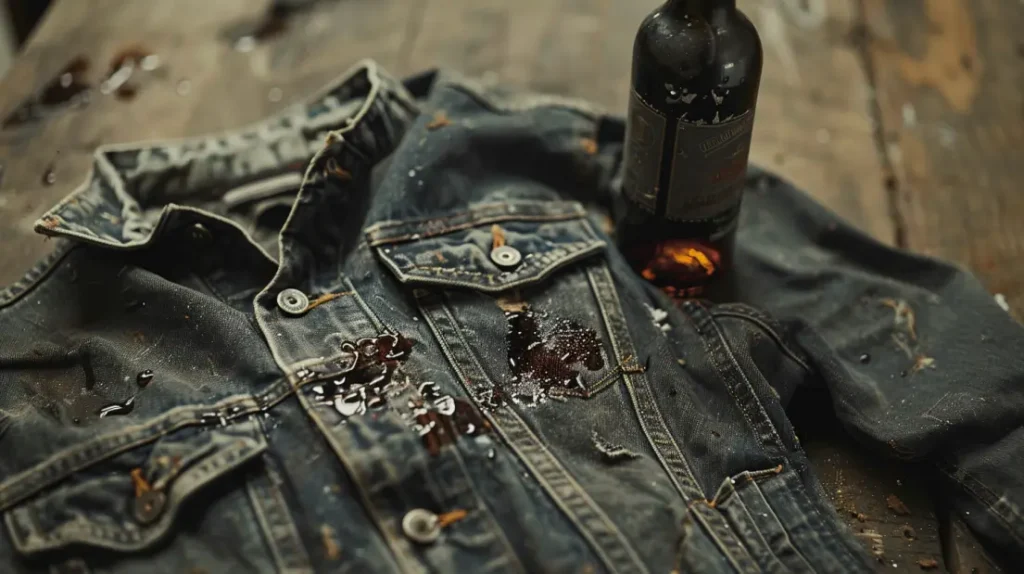Ever found yourself staring at an ink stain on your favorite shirt, wondering if it’s ruined for good? You’re not alone. Ink stains can feel like a disaster, especially when they show up on clothes, furniture, or important documents.
But don’t worry, there’s hope! This article will explore whether alcohol can be your go-to solution for tackling those pesky ink stains. You’ll discover practical tips and tricks to save your belongings and maybe even a few surprises about why alcohol might just be the hero you need.
Key Takeaways
- Types of Ink and Their Challenges: Different types of ink stains (water-based, oil-based, gel, permanent, and printer ink) require varying approaches for effective removal.
- Effective Use of Alcohol: Alcohol is a versatile solvent that can effectively dissolve and lift ink stains from various surfaces such as clothes, furniture, paper, walls, and carpets.
- Testing Fabrics: When using alcohol on fabrics, always test on a small, inconspicuous area first to ensure there’s no damage or discoloration.
- Alternatives to Alcohol: If alcohol isn’t suitable, other methods like commercial ink removers and natural remedies (e.g., white vinegar and cornstarch, lemon juice and salt, milk) can also be effective.
- Practical Tips: Pre-treat ink stains before washing, and always use blotting techniques rather than rubbing to prevent spreading the stain.
Understanding Ink Stains
Ink stains can be tricky to handle, but understanding their nature helps in tackling them effectively. Ink comes in various forms and lands on different surfaces, each requiring specific approaches for removal.
Types of Ink
Different types of ink react differently to cleaning agents. Here’s a quick overview:
- Water-Based Ink: Found in most pens, markers, and highlighters. These inks are usually easier to remove because they’re soluble in water.
- Oil-Based Ink: Common in ballpoint pens and some markers. They can be more stubborn to clean due to their water-resistant properties.
- Gel Ink: Used in gel pens and some specialty markers. Gel ink, while water-based, tends to have more vibrant colors and thicker consistency, making removal slightly harder.
- Permanent Ink: Found in permanent markers and some art supplies. Designed to be long-lasting, these inks are the most challenging to remove.
- Printer Ink: Used in home and office printers. This type can be either dye-based or pigment-based, affecting its removal process.
Common Ink Stain Surfaces
Ink can land on various surfaces, each needing a different cleaning strategy:
- Clothes: Fabrics like cotton and polyester are common victims. Pre-treating with alcohol before washing often gives the best results.
- Furniture: Upholstery, wood, and leather can all get stained. Test a small area first, then use alcohol on a cloth to gently blot the stain.
- Paper: Important documents can get ink stains too. Dab a cotton swab dipped in alcohol gently to avoid damaging the paper.
- Walls: Painted walls and wallpaper might get ink marks. Spot clean with a cloth soaked in diluted alcohol.
- Carpets: Rugs and carpets can absorb ink quickly. Blot the stain with alcohol and avoid rubbing, which can spread the ink.
Understanding these aspects helps you choose the right approach to remove ink stains effectively.
The Science Behind Alcohol as a Stain Remover
Alcohol effectively removes ink stains due to its unique chemical properties. It’s especially useful for different types of ink stains on various surfaces.
Properties of Alcohol
Alcohol is an organic solvent. Its molecules break down a wide range of substances, including ink. It evaporates quickly, leaving minimal residue. Common types include isopropyl alcohol and ethanol. Both are effective in stain removal.
How Alcohol Interacts with Ink
Ink comprises pigments and dyes mixed with solvents. Alcohol dissolves these pigments, lifting the stain. Water-based inks dissolve easily in alcohol, while oil-based inks require more effort. Permanent inks contain stronger pigments that alcohol can partially break down. Rubbing alcohol on a stained area disrupts the bond between the ink and the material. This action makes it easier to blot away the ink. Test a small area first to ensure there’s no damage to the material.
Evaluating Alcohol’s Effectiveness on Different Fabrics
Understanding how alcohol interacts with various materials is essential in effectively removing ink stains. Different fabrics react differently to alcohol, and testing first ensures no damage occurs.
Testing on Cotton
Cotton, a natural fiber, often handles alcohol well when removing stains. Before applying alcohol, blot the stain with a paper towel to remove excess ink. Soak a cotton ball or cloth in isopropyl alcohol. Dab the stained area gently, avoiding rubbing to prevent spreading. Patience is key, as the stain may take a few minutes to dissolve. Once the ink begins lifting, rinse the area with cold water to remove any residue. Repeat the process as needed.
Testing on Synthetic Fabrics
Synthetic fabrics like polyester and nylon, common in clothing, require careful handling. Start by blotting the ink stain with a clean cloth. Apply a small amount of rubbing alcohol to a hidden area to test for colorfastness. If no discoloration occurs, use a cotton swab dipped in alcohol to treat the stain. Work from the edges toward the center to contain the ink. Avoid saturating the fabric, as too much alcohol can penetrate synthetic fibers unevenly. After the stain lifts, rinse the area with cold water and blot dry. Repeat if necessary, always checking the fabric’s condition.
Alternative Methods to Remove Ink Stains
If alcohol isn’t an option, other methods can effectively remove ink stains from various surfaces. These alternative methods leverage different products and techniques to address stubborn ink spots.
Commercial Ink Removers
Commercial ink removers are specifically formulated to tackle ink stains. Brands like Amodex, Goo Gone, and Ink Away offer targeted solutions.
- Amodex: Effective for various fabrics, including cotton. Apply a small amount directly to the stain, then use a brush to work it in. Rinse with cold water.
- Goo Gone: Suitable for hard surfaces and some fabrics. Apply the remover, let it sit for a few minutes, then wipe clean with a cloth. Test on a small area first.
- Ink Away: Best for clothing and upholstery. Spray it on the stain, wait a few minutes, then blot with a clean cloth. Repeat as needed.
Natural Remedies
Natural remedies provide eco-friendly alternatives for removing ink stains from different materials. These remedies use household items you may already have.
- White Vinegar and Cornstarch: Create a paste with equal parts of vinegar and cornstarch. Apply it to the stain and let it dry. Brush off the residue and wash the fabric.
- Lemon Juice and Salt: Lemon juice’s acidity helps break down ink. Squeeze lemon juice on the stain and sprinkle salt over it. Allow it to sit for an hour, then rinse with cold water.
- Milk: An effective method for ink stains on fabric. Soak the stained area in a bowl of milk overnight, then launder as usual.
Using these alternative methods can help you tackle ink stains effectively without relying solely on alcohol. Each technique offers a different approach, ensuring you have options based on the materials and products available.
Conclusion
Tackling ink stains doesn’t have to be a daunting task. You’ve got a variety of options at your disposal, from alcohol to commercial products and even natural remedies. By testing first and choosing the right method for your fabric, you can effectively remove those pesky stains without causing damage. Whether you prefer eco-friendly solutions or specialized products, there’s a method that fits your needs and materials. So next time you face an ink stain, you’ll be well-equipped to handle it with confidence. Happy stain-fighting!
Frequently Asked Questions
What is the best method to remove ink stains from cotton fabric?
Testing alcohol as a stain remover is often effective for cotton. Apply a small amount to an inconspicuous area first to ensure it won’t cause damage.
Can alcohol be used on synthetic fabrics to remove ink stains?
Yes, alcohol can effectively remove ink stains from synthetic fabrics, but always test it on a hidden area first to avoid potential damage.
Are there any commercial products for ink stain removal?
Yes, products like Amodex, Goo Gone, and Ink Away are specifically designed for removing ink stains from various surfaces and fabrics.
What natural remedies can be used to remove ink stains?
Household items like white vinegar, cornstarch, lemon juice, salt, and milk can be used as eco-friendly alternatives for ink stain removal.
Is it necessary to test stain removers before using them?
Absolutely, testing stain removers on a small, hidden area of the fabric is crucial to prevent any potential damage or discoloration.
How does white vinegar help in removing ink stains?
White vinegar acts as a mild acidic cleaner that can break down ink particles, making it easier to wash them away.
Can lemon juice effectively remove ink stains?
Yes, the acidity in lemon juice helps to dissolve ink stains, but it should be used carefully to avoid bleaching the fabric.
What role does cornstarch play in ink stain removal?
Cornstarch can absorb ink, lifting it from the fabric when mixed into a paste with water and applied to the stain.
How should milk be used to remove ink stains?
Soaking the stained area in milk for a few hours can help break down the ink, after which the fabric should be washed as usual.
Is Goo Gone suitable for all types of fabrics?
While effective, Goo Gone should be tested on a small, hidden fabric section first to ensure it doesn’t cause damage or discoloration.
What should I do if the ink stain persists after using these methods?
If the stain persists, try repeating the removal process or consider consulting a professional cleaner for more stubborn stains.



